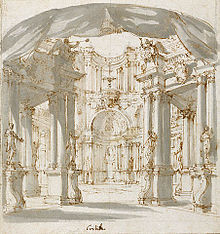Tito e Berenice
The Quirini chose Antonio Salvi to write the libretto for their opera, Lucio Papirio (based on the life of Lucius Papirius), and Francesco Gasparini to compose the music.
[3] According to a French correspondent at the time, Ottoboni "interfered" considerably in the writing process of the libretto for Tito and Berenice, making numerous modifications.
However, according to musicologist Reinhard Strohm, Handel may have borrowed elements from Capece's libretto (and Juvarra's stage designs) for Titus l'Empereur, an unfinished opera project which he worked on from 1731 to 1732.
[10] Although neither Tito e Berenice nor Lucio Papirio achieved lasting success,[11] musicologist and theatre historian Mercedes Vitale Ferrero has noted that they marked three important innovations in the development of opera in Rome.
While based on subjects from ancient Rome, they took as their models the classical French heroic plays of Corneille and Racine, and did not imitate Venetian opera of the day which obligatorily included comic characters no matter how serious or tragic the story.
Rather than focusing on spectacular special effects and stage machinery for their own sake, his sets were specifically designed to reflect and enhance the action taking place within them.


